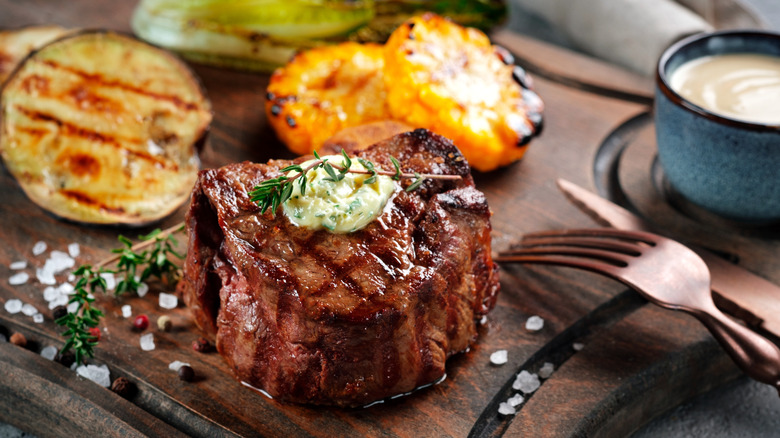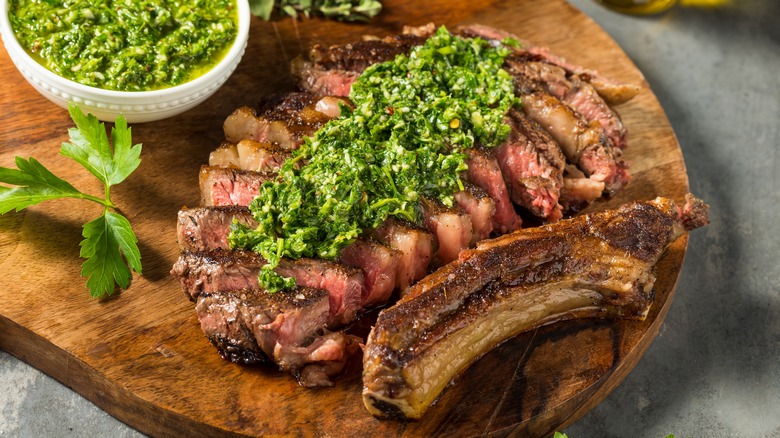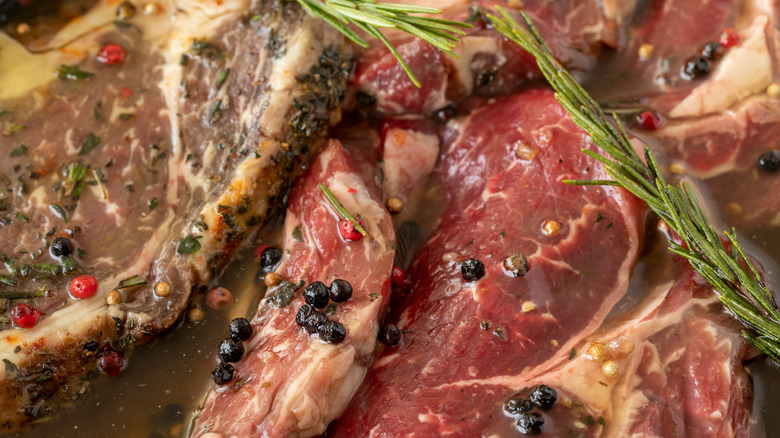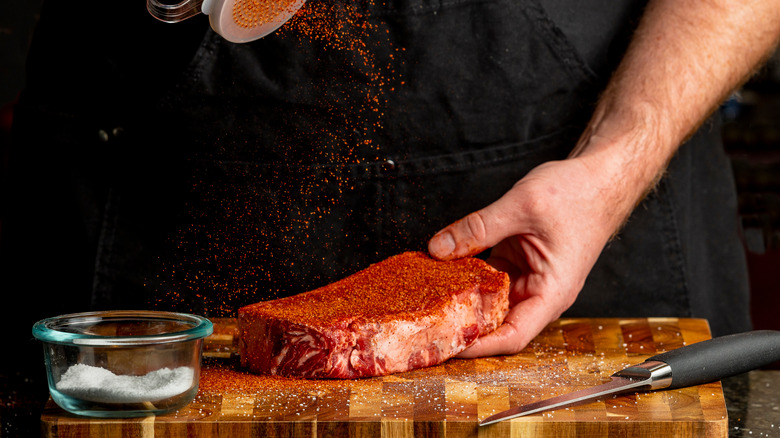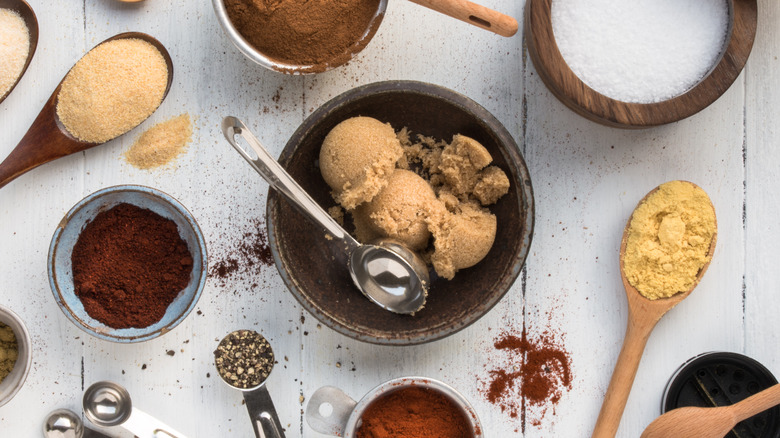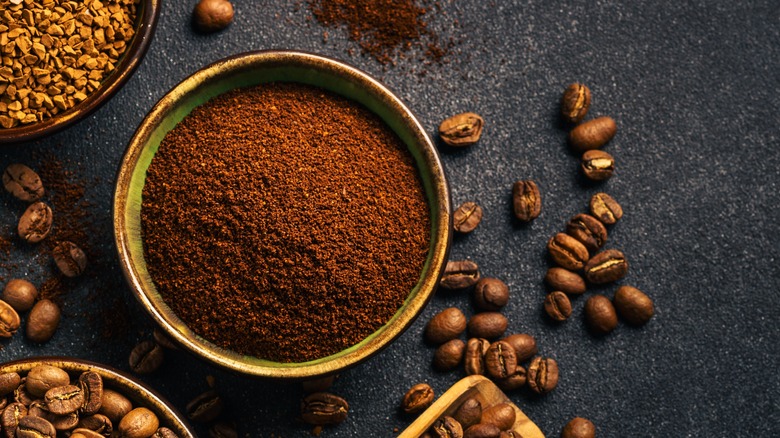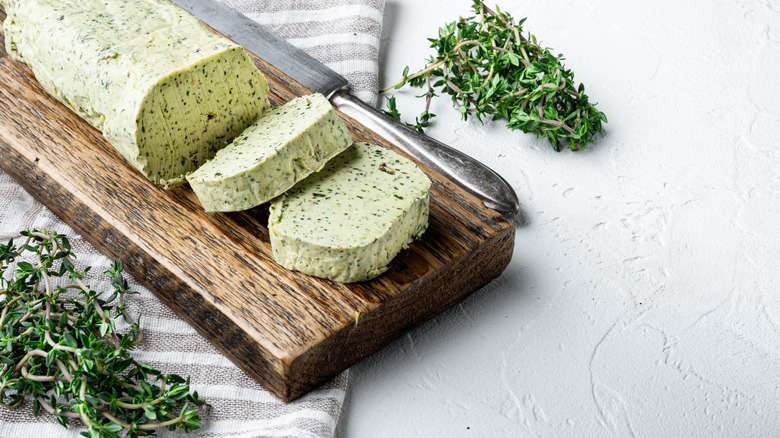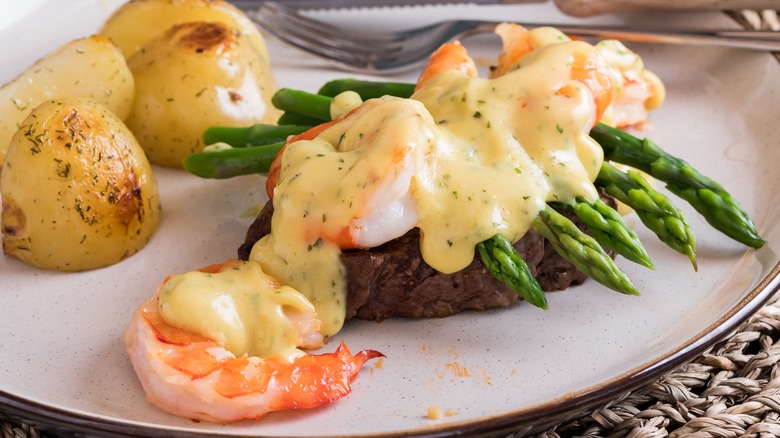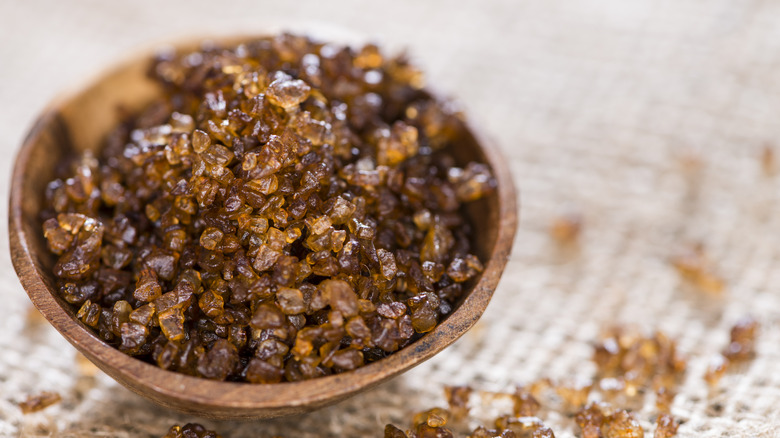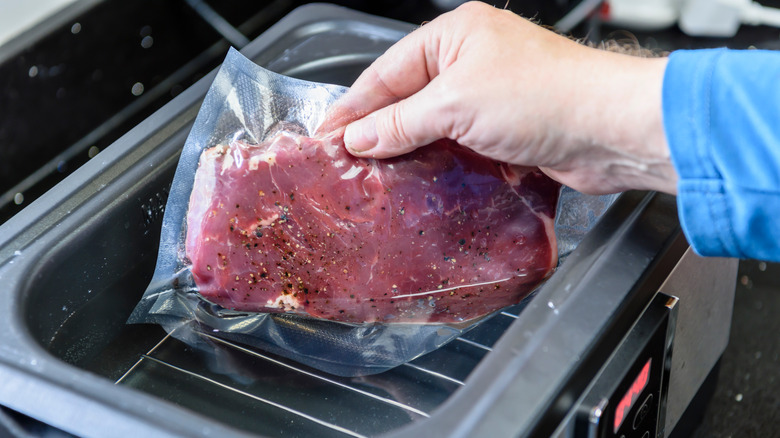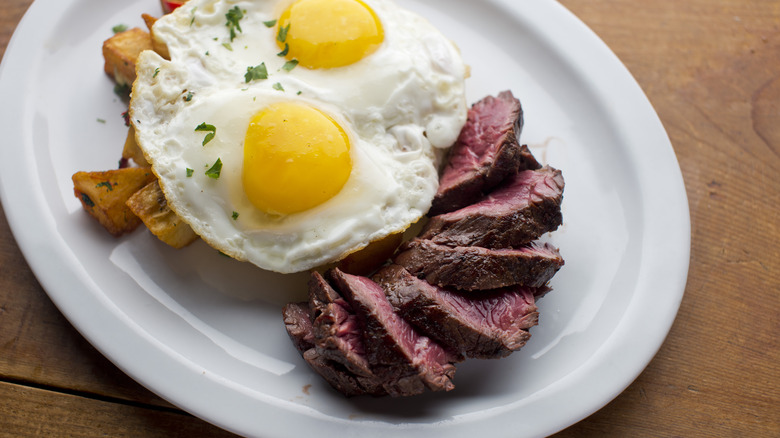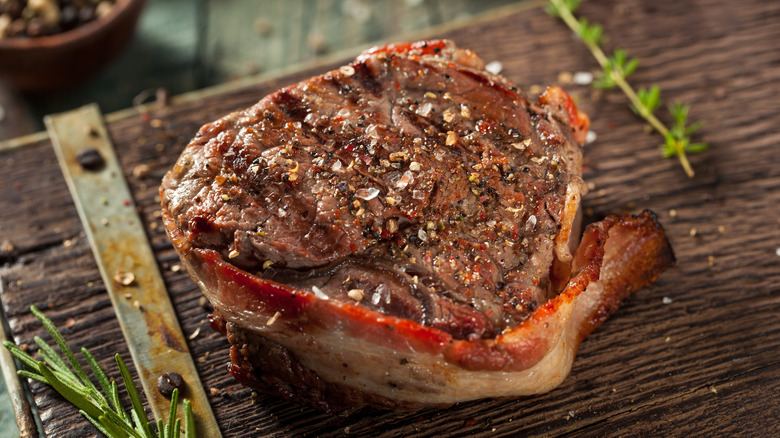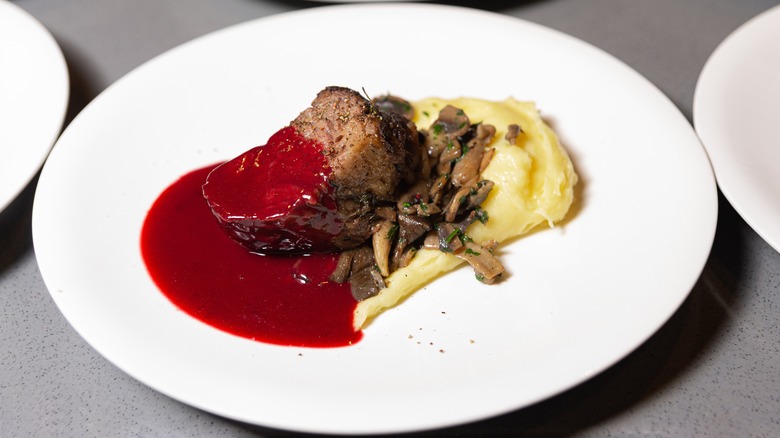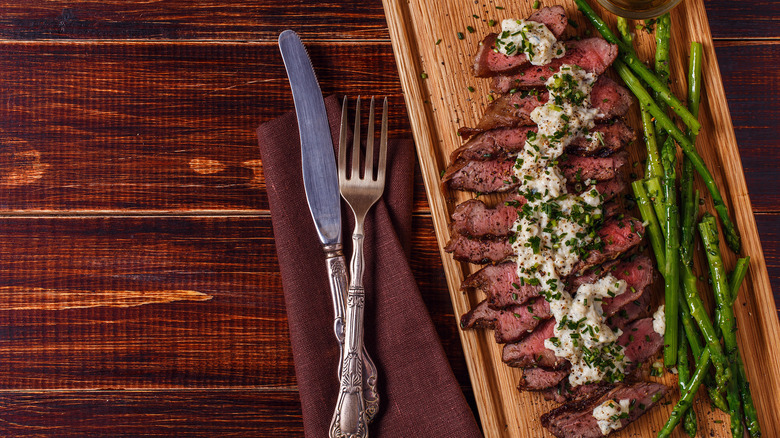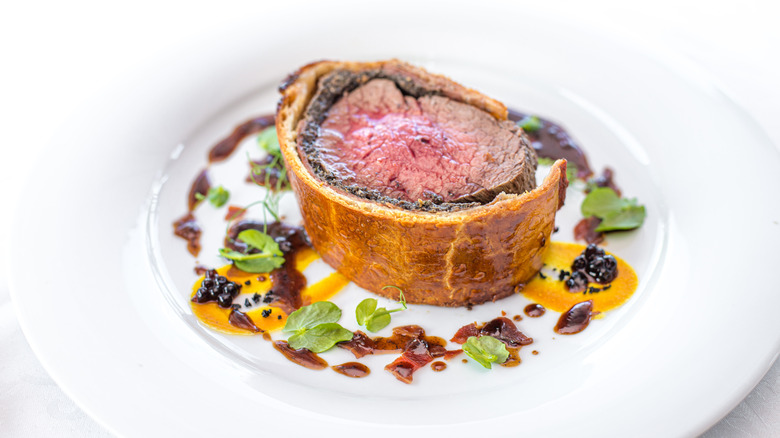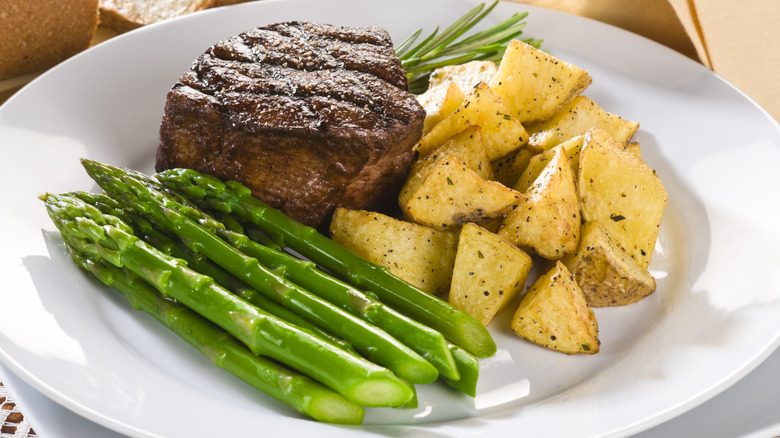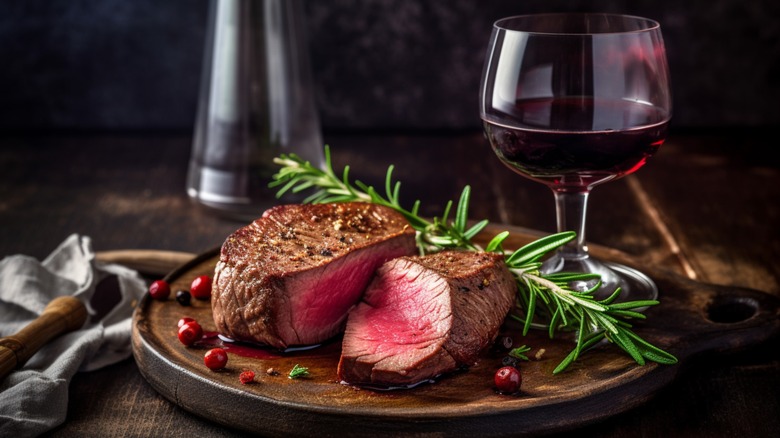16 Creative Ways To Elevate Your Steak Dinners, According To A Chef
There is something about dining at a fancy steakhouse that makes you feel special. From the decor and service to the superior meat quality, the experience seems like something you cannot recreate within the confines of your own home. Take it from a chef with nearly 18 years of experience that there are some tips and tricks that you can implement to reproduce even the most elegant and expensive steakhouse dinner from the comfort of Chez Vous.
While the first step to executing a steakhouse-inspired dinner at home begins with selecting the best cuts of meat and cooking those steaks to perfection, that is not all it takes to recreate the experience. There are several diverse and creative ways to elevate a steak dinner from mundane to marvelous. From specialty sauces and garnishes to selecting the perfect side dishes and pairing the appropriate wines, many seemingly imperceptible choices can give your guests that steakhouse dinner vibe.
If you want to save money, delight your friends and family, and enjoy one of the best meals of your life, you will want to arm yourself with these secret tools of the trade. Use my expertise to inspire you to be the prestidigitator of pleasure and the maestro of meat.
1. Whip up a specialty sauce
One of the most frequent comments I get from guests besides how I cooked the perfect steak is: "What was in that sauce?" There is a perception that sauces are some impossibly challenging thing to execute or a form of witchcraft requiring proprietary ingredients reserved for shamans and secret societies. This is likely because they can transform a steak from simple to spectacular, even if it is a mediocre cut or is poorly cooked.
The key is to think outside the box and move beyond the standard steak sauce. Beef is rich in savory notes and can easily be complemented by bold flavors, including sweet, salty, spicy, and acidic ingredients. You don't want to drown the meat in the sauce but rather accent its inherent umami-rich taste profile. While classic French mother sauces are always a good bet, I enjoy more exotic flavors from other cultures, such as an herbaceous Argentinean-inspired chimichurri or an unctuous, chocolatey Oaxacan mole poblano.
2. Soak it in a marinade
There is a belief that you only need to marinate tough cuts of meat, like a flank or hanger steak, to help tenderize them, but this is not necessarily the case. Any cut of beef can benefit from a brief soak in a flavorful marinade to boost its taste, even if it is an inherently tender cut, like a filet mignon. In this case, it is crucial not to over-marinade your meat as the acidic components can denature proteins, rendering the beef mealy. An hour or two will suffice; and don't forget to pat the meat dry before you cook it to encourage the commencement of the Maillard reaction.
When determining ingredients for a marinade, the sky's the limit with what you can incorporate. Many unusual additions — from Dr Pepper to all kinds of alcohol – can infuse your meat with delectable flavor. Regardless of the precise combination you choose, you will want to lean into umami-rich ingredients to help amplify the inherent savoriness of beef.
3. Get creative with your seasonings
Beef requires quite a bit of salt to amplify its inherent meaty flavor and achieve the desired juicy texture, but don't limit yourself to it. Different dry rubs and brines can transform your steak into something transcendent. Knowing what ingredients to use and when to apply them to your steak takes finesse.
For a basic dry rub, you want to keep things relatively simple, choosing a handful of high-quality spices and herbs, like smoked paprika, garlic powder, and herbes de Provence, and applying them to the meat that has been patted dry just before searing it to develop that perfect crust. If you plan to do a dry brine, do so for at least 24 hours before rinsing the seasonings off and patting the moisture off your meat. Dry brines with intense flavors work because they have plenty of time to permeate the muscle fibers, seasoning the meat throughout rather than just on the surface. I enjoy ethnic spice blends alongside kosher salt in my dry brines, like ras el hanout and garam masala, to develop that complexity.
4. Rub it with sugar
There is another ingredient that can amplify the inherent meatiness of beef while tenderizing it and helping to create a distinctive crust that is delightful to cut through once it has seared: sugar. Sugar-crusted steak is not exactly a novelty. The technique has been well-documented by chefs for taking even the most basic cut of beef to the next level.
You will want to take minor precautions when using this technique to retain the balance of sweet and savory flavors and prevent your steak from burning. This process works best with a dry brine where the sugar can permeate the beef for up to 24 hours. A ratio of four parts granulated or brown sugar to three parts salt works well to maintain the perfect harmony of flavors. Just before the steak is cooked, reapply the rub to reinforce the taste and encourage the crisp crust to form. And don't forget to rotate your meat frequently to keep the sugar from blackening. When cooked, rest the meat adequately for three to five minutes to allow the juices within to redistribute and the sugar crust to harden.
5. Coat it in coffee
Coffee has some pretty impressive superpowers when using it on beef. Its natural acidity can tenderize the meat while infusing it with intense flavors akin to alcohol. Though tossing some leftover brewed coffee into a marinade works quite well, combining kosher salt and dried herbs or spices with ground coffee for a last-minute rub is even more effective.
The best rule of thumb is to use a lighter roast, medium-ground bean for this task. A small amount will do you, as any more can overwhelm the inherent savory flavor of beef rather than complement it. Once your steak is seared, the coffee crust encases the meat, developing a crisp exterior to juxtapose the perfectly juicy beef. When using a coffee crust, it is crucial to pair sauces carefully with your meat. One of my favorites for this application is gorgonzola or Roquefort cheese-based sauces. Their intense flavor easily stands up to the bitterness of the coffee without competing too much with the naturally umami-rich meat.
6. Create a compound butter
Compound butter combines flavor infusions that tickle your fancy with softened butter, from fresh herbs and aromatics to salty bacon bits and pure maple syrup. It can be made in advance and stored in the refrigerator to elevate many foods, from freshly sautéed vegetables or grilled corn to a perfectly seared steak. The simplicity of taking a cold slice of compound butter and garnishing a hot steak to season it seems too easy to be effective. That's what makes it such a wonderful thing and why steakhouses so often use this trick to amplify the natural flavors of their meat.
Go bold with ingredients when searching for flavor infusions to create a compound butter for your next dinner party. Umami-rich items like truffles, capers, or anchovies are always a good bet, as are spicy elements like gochujang, sriracha, or chipotles. And don't be afraid of those alliums. Chives, caramelized onions, and roasted garlic are always a good bet for a punch of flavor that will send your steak into the stratosphere.
7. Pair it with seafood
The origins of pairing savory beef with buttery, rich seafood are contested, with some pointing to the West Coast and the restaurant perched on the Seattle Space Needle during the 1962 World's Fair, and others suggesting it emerged on the East Coast, as indicated by an ad for Champagne Surf 'N Turf Dinner published by the Massachusetts newspaper, The Lowell Sun. Regardless of where it began, the combination has stuck, with steakhouses offering many different iterations of this match made in heaven.
Though shrimp and lobster are popular seafood items in this combo, plenty of others fit the bill. One such dish that has even earlier origins is Steak Oscar. This combination of steak served with crab meat, asparagus, and béarnaisse sauce is believed to have been created in 1897 for King Oscar II, monarch of a united Sweden and Norway. The original likely featured veal, but the modern iteration focuses on a tender filet mignon. Though this dish requires some sophistication and technique, it is a showstopper and will impress your dinner guests.
8. Garnish with a finishing salt
Finishing salts are intended to be added at the end of cooking. These unrefined salts add flavor and texture to a finished dish, with irregular flakes that slowly dissolve atop hot meat as they come into contact with your warm tongue. Each of these types of salt has distinct flavors depending on where they are sourced from.
They can be purchased au natural or with various flavorings added to them, like truffles, herbs, and spices. There are also smoked iterations of sea salts seasoned by slowly heating the flakes over smoldering wood of different types, like Oakwood, apple, alder, or sandalwood. This process infuses the salt with flavor and color, making it particularly effective at bringing out the savory notes of a seared steak.
When adding finishing salt to your meat at the end of cooking, it is necessary to use restraint. You are not trying to permeate the meat with taste but seeking to amplify the flavor that has already been coaxed out of the beef by pre-seasoning and cooking it.
9. Try different cooking methods
When discussing the perfect ways to cook a steak to attain that professional steakhouse quality flavor, grilling, and reverse-searing are two common techniques. These are consistent, relatively easy techniques to master that yield foolproof results as long as you know the correct doneness for the cut of meat you plan to cook. You will also need to be aware of some of the basic mistakes to avoid, like not drying the beef and bringing it to room temperature before slapping it onto the grill.
That said, I recommend thinking outside the box and implementing more novel culinary methods to prepare your steaks the next time you host a dinner party, such as smoking the meat, cooking it sous-vide, or popping it into an air-fryer. Smoked meat has particularly complex flavor profiles conferred by the wood used and the low-slow cooking process. A steak-cooked sous-vide will be uniformly done to the desired temperature without resulting in shrinkage of the meat. An air-fryer has the benefit of crisping up the steak for a perfectly crunchy exterior that is marvelous when juxtaposed with a juicy, medium-rare center.
10. Add an egg on top
While many foods can be elevated by topping them with eggs, none are more classic or delicious than steak and eggs. You may think this combination must be reserved for your first meal of the day, but there is no reason why you should not consider it when hosting your next steak dinner. Though standard recipes use pan-fried eggs over easy-to-top slices of a medium-rare sirloin, rib eye, or New York strip steak, virtually any cut of meat or egg preparation method can be used for this recipe.
For my money, a poached egg is the ideal topping for steak. The runny yolk creates an almost cheese-like sauce that coats the meat when you cut into it. The resulting bite is spectacular when the hot meat is dipped into the runny eggs. If you have an aversion to soft-cooked egg yolks, fluffy scrambled eggs will work equally well, but remember to add some water to help plump them up or cottage cheese for a rich, creamy flavor.
11. Bacon makes everything better
Something about the umami-bomb that is bacon does make virtually everything better — even steak. Wrapping bacon around a steak does a couple of things. First, it confers a delicious, smoky flavor that amplifies the inherent savoriness of the beef. Second, and more importantly, it helps keep your steak incredibly moist. Even if you prefer your meat done more on the medium or medium-well side, you can still enjoy a juicy steak if you encase it in bacon.
When wrapping bacon around your steak, par-cook it before doing so. This will help the bacon crisp up before the steak is overcooked rather than leaving it floppy and underdone — something I despise. I also recommend searing or grilling the edges of the steak when cooking it to get some color onto the bacon surrounding it. If you want to elevate the bacon goodness of your meat even more, use bacon grease to sear your steak.
12. Make a red wine reduction
If you have ever eaten a steak at a fine dining establishment, you have likely consumed a red wine reduction. Many restaurants use this culinary technique to amplify beef, lamb, or game meat, keeping an enormous pot of red wine infused with herbs and aromatics slowly simmering on the stove 24 hours a day. Slowly reducing red wine allows the liquid and alcohol to evaporate while concentrating the flavors, rendering a syrupy, rich sauce capable of enrobing a perfect bite of steak.
You can easily recreate this at home with patience and a quality bottle of wine. The best wines for this application are full-bodied, dry reds with moderate acidity, a decent amount of tannins, and not much residual oakiness. Merlot, Cabernet Sauvignon, and Pinot Noir are usually good bets for this purpose. This is not the place to splurge on an expensive bottle of wine, but you should buy one that you find pleasing to your palate.
13. Say cheese
Cheese is one of those foods that can transform virtually any meal when carefully selected and used judiciously. In the case of steak, not only does cheese complement the flavor of the beef, enhancing umami notes, but it amplifies the texture, slowly melting over the hot meat and enrobing it for a luxurious mouthfeel.
Unlike other dishes where the capacity to melt is what makes a cheese optimal for use in a recipe, when it comes to steak, you want to focus on strongly flavored, pungent cheeses that can either be turned into a sauce or used as a garnish atop a perfectly cooked, medium-rare cut of meat. Stilton, Roquefort, gorgonzola, and smoked blue cheeses are commonly featured alongside steak. That said, feta, brie, boursin, and goat cheese can easily be substituted, particularly in sauces. When making a cheese sauce for steak, I typically skip the roux and allow the cheese itself to thicken the sauce naturally.
14. Wrap it in puff pastry
Beef Wellington is a recipe befitting royalty. It combines beef tenderloin, rich paté, and mushroom duxelles wrapped delicately in puff pastry. Though its origins are a mystery, the culinary technique of wrapping meat in pastry can be traced back to the ancient Greeks. In many cultures, this process was a logical solution to a problem that had yet to be solved, namely, how to create a meal that could easily be transported and eaten with one hand. These rustic pies may be a far cry from the dish that experienced a renaissance in the 1960s thanks to Julia Child and her iconic television series "The French Chef."
When it comes to home cooks, variations of this classic are relatively simple to recreate, even if they appear to be labor-intensive and complicated. Ingredients can be swapped or simplified as needed, and if a whole beef tenderloin is a bit out of your budget, consider making individual beef wellingtons. These mini versions are always a crowd-pleaser, with the flaky pastry dough keeping the meat moist and juicy inside.
15. Don't snooze on the sides
You are missing a huge opportunity to elevate your meal to the next level if you are skimping on the side dishes, even if the meat may be the star when preparing the ultimate steakhouse dinner. Side dishes can make or break the meal, the way supporting actors can launch a movie into Oscar contention or tank it. Though steak and potatoes are the classic go-to, spuds are not the only sides that can help showcase your perfect cut of beef. From whipped sweet potatoes to a hearty rice pilaf, many other starches will work.
I also always include a vegetable for color, flavor, and texture. Though fresh and in season is best, steakhouse favorites include roasted or steamed asparagus and sautéed green beans. Regardless of the vegetable you choose, do not overcook it. You want them to be al dente and to retain elements of their freshness while being well seasoned. Don't be afraid to look for alternative cooking methods, like roasting or frying your veggies, to create diversity in mouthfeel.
16. Pair it with the right wine
The right wine can also make or break a meal, particularly when planning a fancy steakhouse dinner. Though you may not have access to, or the funds, to purchase a fancy reserve wine the way a restaurant can, there are plenty of great ways to incorporate wine into your meal that are affordable and delicious.
While some wine pairings are standard, the wine you choose to drink with your steak is a matter of personal preference. Red wine is typically believed to be the ideal choice when eating steak because its bold flavor and aromatic notes stand up well to the savoriness of meat. However, a dry, acidic sauvignon blanc or buttery chardonnay could easily suffice. I appreciate white and red wines, but sometimes reds can be too heavy for a hot summer night, even if eating steak. A crisp, chilled white wine is far more refreshing and can allow me to appreciate the meat without overwhelming it or me. When entertaining, provide something for everyone, both white and red.
